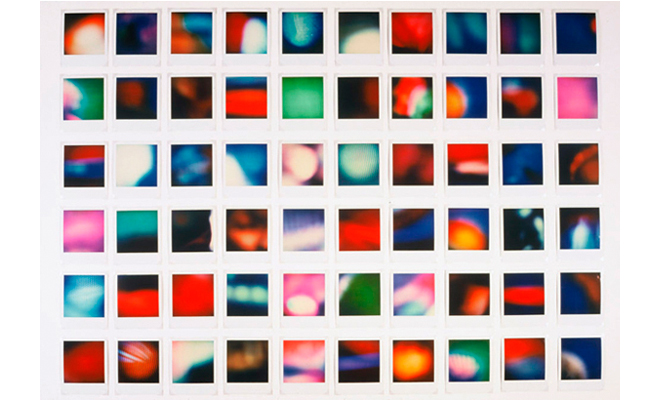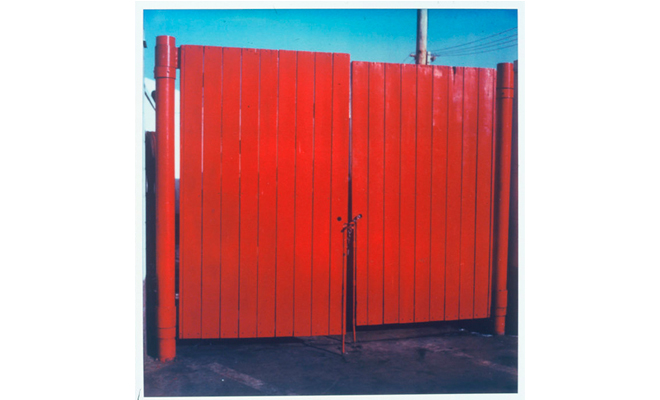Review: Richard McCabe at the Art House on the Levee

Richard McCabe, Equivalents, 2000-2002. 60 SX-70 Polaroid prints. Courtesy the artist.
Editor's Note
Today is listed as the last official day to see Richard McCabe's “The Polaroid Years” at the Art House on the Levee, but the Pelican has received word that McCabe will keep the exhibition open by appointment until January 12. Emily Wilkerson reviews:
Photographer Richard McCabe moved to New York City in 1998, and although he had little money, no darkroom, nor a studio, McCabe was armed with the energy of a newly acquired MFA and a strong desire to participate in the stimulating art environment of the city. With a SX-70 and a Polaroid Land Model 230 in hand, he created instantaneous compositions inspired by his surroundings. The tactile products of the Polaroid camera McCabe came to rely on for its low cost and easy exposure now form the subject of his exhibition “The Polaroid Years,” currently on view in conjunction with PhotoNOLA.
In this exhibition, McCabe showcases neatly matted and framed Polaroid photographs taken over a five-year period in New York City and Pensacola, Florida, the artist and curator’s hometown. Positioned evenly in the front room of his residence, the works create a steady pathway for viewing that emits the same ease as using the casual medium on display. The format and imagery in the exhibition are familiar—small, shiny photographs of corner stores, street scenes, and sites stumbled upon during walking excursions. Among more conventional landscapes, such as the night view of a graffiti-laden Friendly Food Center, 2003, abstract compositions ignite the imagination. A grid of SX-70 Polaroid prints titled Equivalents, 2002, boasts unexpected shots of a television screen, which produced psychedelic swatches of bright colors against darkness. These same hues return in the blinking signs and vendor booths of Coney Island photographs, hinting at McCabe’s painterly approach to the medium.
Flipping through a stack of unframed SX-70 photographs on display in the back of the room, one is reminded of McCabe’s interest in this particular film. The product is extremely clear, lacking the grainy quality of other Polaroid films. It lends a precision that McCabe consciously challenges by shooting subjects out of focus—a process he refers to as “anti-photography.” Take for example, Colour Lights, 2002, in which colored lightbulbs on a Coney Island sign become blurs of glowing yellow and pink spheres. The viewer is immediately drawn to the colors and composition, rather than a recognizable subject.
At approximately 3x3 inches, the intimate nature of a Polaroid has always been one of its most salient features, which McCabe accentuates here with thick white matting. Accustomed to large-format displays of digital photographs, contemporary artists such as Blake Boyd and Andrew Garn have turned to the Polaroid as a negative, enlarging the image to produce more dramatic prints—a practice also utilized by Andy Warhol in developing his famous large-scale silkscreens. However, McCabe’s decision to exhibit his photographs in their primary format is crucial. His works exist as small tokens of immediacy in their original form. And with the discontinuation of original Polaroid film and trends in technology to recreate the nostalgic feel of the medium through smartphone apps and computer programs, McCabe’s photographs remind the viewer of the irreplaceable physicality of the Polaroid, conveying moments of “instant joy” and re-activating their importance both then and now.

Richard McCabe, Red Gate, 2002. SX-70 Polaroid print. Courtesy the artist.
Editor's Note
"The Polaroid Years" extended by appointment until January 12, 2013 at the Art House on the Levee (4727 Dauphine Street). To visit contact the artist at 504.450.6235. Regular hours Saturday, December 22, 1-5 pm.



